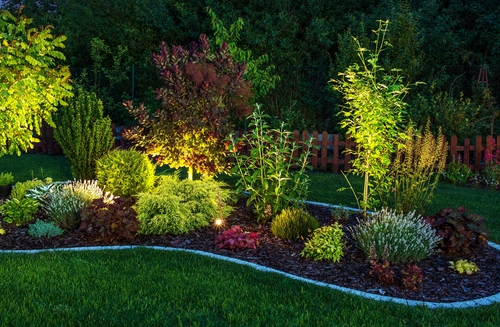Archive for Garden Design
Rock Garden – It’s More Than What Meets the Eye
Contrary to popular opinion, there is more to a rock garden than a garden filled with rocks. In reality, it is a blend of plants and rocks complimenting each other.
Unlike easterners, mainly Japanese who use rock gardens to find enlightenment, we in the west are more focused on creating beautiful spaces that are a pleasure to look at and relaxing.

Before we get into how you can use the rocks, here are some few benefits of having a rock garden.
- First, these gardens can survive harsh climate. You can throw anything at them from extreme winters to sweltering heat, and they will endure. Strong winds or droughts will no longer be a concern.
- They are low maintenance. Unlike customary gardens, these are easy to maintain as they don’t require frequent feeding, watering, mowing, aeration, or control of pests. Moreover, the rocks can be placed around the plants to control weeds reducing the need for chemical control. They are ideal for people who lead busy lives.
- Also known as Zen gardens, you will appreciate that they look great all year round. However, you should use a combination of plants that bloom in spring and summer together with evergreens and fall foliage.
- Rocks allow you to create depth and diversity by combining tiny pebbles with large boulders.
- Rocks also create the illusion that your yard is large. Seeing as you use fewer plants than traditional yards, you create the perception that your yard is extensive.
How you can use rocks around the garden
You can use different stones to create a specific impact depending on what you want.
First, if you are looking for ambiance or a casual, laid-back garden, an area you can sit and relax; we recommend beach pebbles or river rocks. These add warmth, are pretty inviting, and are customizable seeing as they are available in various sizes and colors.
You can also use rocks to control weeds. Place them around your plants and flower beds, and fill up those empty spaces between plants as mulch.
You can use white marble chips to create a cheerful and bright space. They are especially useful in shady areas as their bright color will contrast with the dark soil and general ambiance there. You can also use dark marbles to balance out a bright area.
A rock garden will come in handy if you have a steep slope or uneven surface. Some of these spaces are difficult to mow and maintain. However, you can use rocks to transform it into a showcase of more delicate plants.
You can also use stones to create a border around your ponds. They are great for camouflaging the liners and creating contrast with the water for a dynamic look.
Conclusion
Rock gardening can give you a sense of sophistication and class. It is rare but beautiful, and the rocks and greenery compliment each other superbly.
However, it takes expertise to create a terrific rock garden. There is a ton of technical knowledge and experience required, and we encourage you to hire professional landscapers. You can contact us to book an appointment for garden maintenance, irrigation, water saving landscape design, and rock gardens. Contact us for more information.
Outdoor Space Improvement: Simple Garden Ideas for Beginners
Establishing a garden on your property can be highly beneficial. In general, a home garden can be used for growing consumable produce or decorative plants. You can make your property more beautiful by planting flowers and other appealing plants in your garden. Alternatively, you can choose to plant vegetables, herbs and fruits. You will have access to fresh produce at a low price. It is possible to combine both categories of plants for a perfect garden.
If you are new to gardening, you might find starting the process challenging. Here are some basic garden ideas and simple guidelines for a smooth beginning.
Understand Your Environment
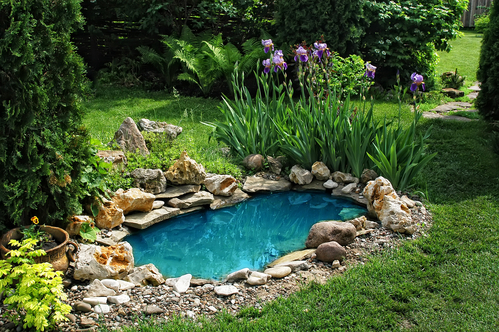
It is essential to learn more about your environment before starting the gardening work. If you are knowledgeable, you will increase the rate of success from the beginning. For the best results, choose a perfect spot on your property to start a garden. The spot should have adequate sun exposure. Too much or little sunlight will damage plants. It is also advisable to check the condition and properties of the potential gardening soil. Once you understand the specific characteristics of your garden, you can choose the most suitable plants to match the unique environment.
Consider Container Gardening
If you do not have enough space on your property, consider choosing container gardening. This one of the most beneficial and popular garden ideas in the modern home environment. You will be able to enjoy flowers or produce even with limited space. In addition, container gardening gives you more control. For instance, it is possible to grow any kind of plant because you can prepare unique soil material and move the container to different places for optimal environmental conditions. If you decide to take up container gardening, consider taking advantage of space on your patio, deck and rooftop.
Look into Vertical Planting
Most people opt for garden plants that remain close to the ground. If you are interested in a fresh idea for your home, think about growing some vertical plants. As implied, vertical planting involves establishing plants which grow upwards by climbing onto fences, stakes or trellises. This type of gardening can help you maximize your limited space. It also creates unique aesthetics in the home. In addition, this is the perfect gardening choice for people who might find squatting and bending difficult.
Choose Seeds or Starter Plants
Once you have decided on your ideal gardening style, you can begin choosing plants for your project. When selecting the perfect plants, it is advisable to keep your environment in mind. Some vegetables, herbs and flowers will not thrive in certain environments. Therefore, opt for plants which can grow with ease in your home. You will also need to choose whether to acquire starter plants or seeds. For a beginner, starter plants or seedlings are the most suitable. This choice will eliminate your worries about sprouting. On the other hand, seeds are cheaper, and you will find diverse plant species.
Utilize Companion Planting Methods
Consider utilizing a companion planting technique in your garden for better results. This approach is perfect if you would like to have a mixture of plants on your space. Companion gardening involves planting different complementary species of plants together so that they will benefit from one another. For instance, if you are planning on growing vegetables, you can plant carrots alongside leeks. The lees will repel harmful carrot flies. Note that there are some plants must not be planted together. If two species are affected by the same diseases and pests, avoid planting them together. Contact us for more information.
Backyard Ideas: Follow these Steps for Excellent Xeriscaping
Landscaping is great for the air quality around your home, and the curb appeal. However, many people complain that sometimes, it comes at an extremely high cost. One of the costs which are part of landscaping is water expenditure. Xeriscaping is an alternative to landscaping where the least possible amount of water is used. The beautiful thing about the process is that the quality of the resulting landscape will not be compromised, but a lot of water will be saved. Here, are some of the best backyard ideas on Xeriscaping which you need to try out.
Take note of problem areas
The start of any watering process should be to have a look at all the parts of the yard, and notice the ones which are easy to water, and also those which are extremely difficult to maintain. Steep slopes are usually the most prone to drought. After mapping out these areas, decide whether you want to keep their vegetation cover or not. If you decide that you want the vegetation cover, convert into perennial crops which do not need a lot of watering to stay alive and healthy, especially in the hot season. You might also want to consider drip irrigation to maintain these parts of the lawn.
Manage the size of the backyard garden
Another reason a lot of water gets wasted in irrigation is when the garden has an irregular shape. To combat this, you have to reshape the garden to create shapes which are easy to irrigate. You also need to replace the plants with xeric alternatives such as blue grass and buffalo grass, both of which take wear and tear very well. Buffalo grass can survive on less water; however, it has a low tolerance to interferences such as foot traffic, which makes it best suited for parts of the lawn that will not have a lot of traffic. Section off parts of the garden that are used less often, and turn them into shrub borders and flower gardens, that need less water to thrive.
You can also section off parts of the garden and make them into paths. You can line these paths with stepping stones of flagstones, which is good because it reduces the total surface area which has to be covered with lawn grass. Another tip which will be successful is transforming the rocky parts of the garden into a rock garden. You can use a variety of colorful rocks for the garden and use appropriate rock garden designs. There is a variety of crops which you can add to the rock garden.
Picking the right plants
The best plants for backyard ideas in xeriscaping are native and drought tolerant plants. Remember that xeriscape gardens are created in such a way that they fit Mediterranean and Southwest styles in gardening. You can consult with a landscaping expert to figure out the plants which will be most appropriate for your climate and locality.
When Xeriscaping is planned for and done properly, it produces some of the best gardens. It capitalizes on preserving native plants while at the same time reducing the amount of water used in gardening, and giving the regular landscape of your backyard a special touch. When you involve a competent landscaping expert in the process, the outcome will be amazing.
Four Creative Flower Bed Ideas to Get You Going
Creating sensuous textures and adding color to your garden with a flower bed is one of the quickest ways to improve your yard. And when it comes to flower bed ideas, there’s virtually no limit.
Raised flower beds are getting a lot of attention lately because they’re easier to water and maintain, but that’s far from the only option.
Other options are flower beds that encase trees and create a truly picturesque effect, flower beds that line a walkway to a backyard oasis, and tall flower beds filled with azaleas and wisterias.
Flower Beds Encasing Trees
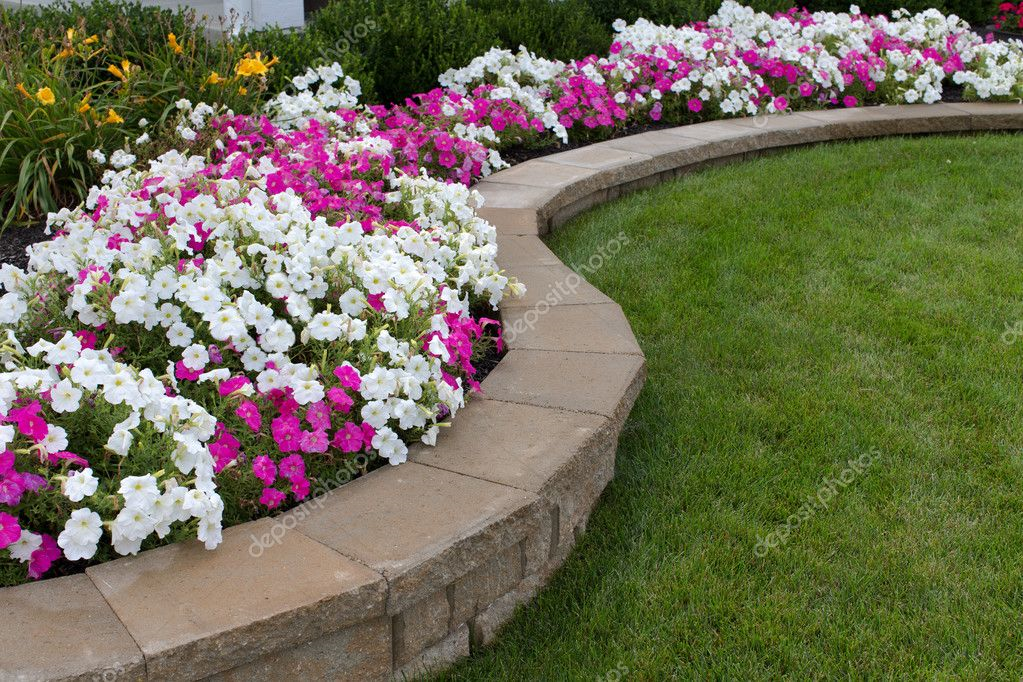
The thing to do when planting flower beds around trees is make sure that you’re selecting the right flowers for your particular region and getting the amount of sunlight versus shading right.
Plants and flowers that are “full sun” are the easiest to work with since they can receive six hours or more of sunshine per day and still be fine.
Yarrow, tickseed, and blanket flowers are all full sun plants that go great around trees. Lavender (purple) and sasha sage (white) pair well together and are both full sun plants. These might well give you the effect you’re looking for.
Circular Flower Beds
If you’re feeling a bit more adventurous, then you might want to consider a few of the flower bed ideas below (including this one!).
Circular flower beds are good if you have a huge tree that you want to draw attention to or a bare spot in your yard that needs a bit more color.
Taking an eclectic approach that gives you a wide palette of color is usually the way to go when it comes to creating a successful circular flower bed.
Bulbs, annuals, and perennials with a nice border flower like garanium can really frame things nicely. Putting something like a bird bath in the center is also an option.
Like these flower bed ideas but feeling overwhelmed with actually pulling them off? Get in touch with a landscaping company that can help you design, build, and maintain your flower bed for years to come.
Flower Beds Along a Walkway
As far as flower bed ideas go, this one’s right up there in popularity with raised flower beds and flower beds around trees.
Flower beds lining your walkway can significantly increase your curb appeal as a homeowner and work well with condos and receptions as well.
In terms of design, planting decorative flowers as a border along your walkway is said to soften the sameness and artificiality of concrete.
A line of flowers adds an unexpected splash of color in an unlikely, though not unwelcome, place.
Landscaping and design experts say to go with flowers that are hardy yet vibrant like mahogany bugleweed (purple) or red ruby.
A landscaping company can plan, edge, and till around your walkway to get things started on the right foot. Composting, mounding the soil, and actually planting the flowers comes next.
Here too landscapers can provide regular maintenance and put your flower bed and lawn on the irrigation and aeration schedule that both need to flourish and bring your outdoor landscape into full color.
Slanted Flower Beds
Slanted flower beds are one of those creative flower bed ideas that’s certainly not right for everyone but could be perfect for many people.
If your front yard is pitched, for instance, a landscaping team can help you raise your dirt bed to level and create a retaining wall that maximizes your flowers’ blooms while minimizing soil compaction.
Grasses and succulents are smart choices for sloped gardens. Contact a professional landscaper to make it happen!
Frequently Asked Questions About Drip Irrigation Systems
“The Secret Of Landscapes Isn’t Creation …It’s Maintenance.”-Michael Dolan
Micro- irrigation systems or drip irrigation as it’s more commonly referred, is basically a form of irrigation that supplies water toplant roots in a gradual manner. Extremely popular for its efficiency and its ability to promote water conservation, drip irrigation systems consist of a network of supply veins which run beneath the topsoil throughout the specified area, to thoroughly and strategically deliver a constant supply of water to plants.
They’re probably plenty of gardeners out there who find drip irrigation systems work well for their gardens but might not necessarily know everything they should about irrigation systems.
Unfortunately, because of this they may run into a couple problems that they may not be able to solve, so this article aims to answer any questions relating to irrigation systems that may prove difficult to answer.
Understanding Drip Irrigation Systems – Frequently Asked Questions & Answers
Q: How do you know if irrigation drip lines are working?
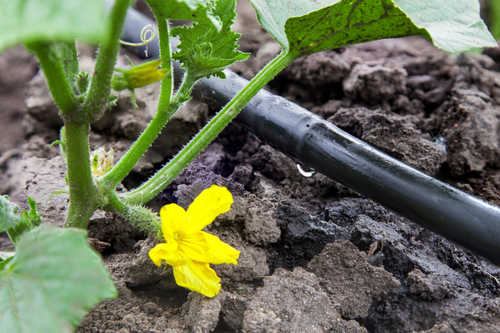
A: Since drip irrigation systems run beneath the topsoil it can be difficult to determine if it’s working. So, by simply observing the area after a few minutes of turning on the system to look for dampness in the soil around the line.
If your soil is mulched, just dig away a small portion of the mulch and soil with your hand and feel the soil to see if it’s moist or not.
Q: What’s the difference between a drip irrigation system and a ground sprinkler system?
A: Both systems function to deliver water to plants however a ground sprinkler system works by spraying a planted area above ground while a drip irrigation systems are located underneath the soil and deliver water directly to roots with a slow, consistent, drip.
Q: What type of garden is drip irrigation best suited for?
A: Drip irrigation systems are best suited for landscape beds with lots of plants and shrubs rather than lawns.
Q: How can a drip irrigation system benefit my garden?
A: Drip irrigation can offer gardens quite a few benefits once installed correctly. For instance, they prevent overwatering of plants and allow plant roots to absorb more water over a longer period of time, however some of the more popular benefits include its ability to promote water conservation, especially in drought-stricken areas and they offer a way for gardeners to save time and money.
Q: What difference will having a drip irrigation system make on my water bill?
A: As you can tell from its name a drip irrigation system practically drips water and emits water at a slower rate than above ground sprinklers or garden hoses.
With various settings, drip emitters may apply water at 0.5 – 4 gallons per hour where a rotor style sprinkler can water between 1 – 6 gallons per minute. See the difference yet?
You see, even though each landscape area differs in size drip irrigation systems can be set so that they have a slower application rate and higher efficiency. Based on this efficiency gardeners are able to reduce water usage by 50%. So, in other words, you’ll be cutting your water bill in half.
Q: Is a drip irrigation system difficult to install?
A: With easy to work with components, the process of installing a drip irrigation system is not difficult though there are certain guidelines you should follow. Basically, the process consists of weaving and arranging the tubing so that the supply of water is directed to the targeted areas.
Need Help With Drip Irrigation Systems?
If you don’t know how instal a drip irrigation system, don’t panic – help is just a call or click away. Don’t exhaust yourself spending hours in the sun struggling with irrigation tubes or worse stand in your garden and not know what to to to install your drip irrigation system. We can help.
Contact us at DK Landscaping Inc., to come in and assist you with professional irrigation system installation. Not only is our team knowledgeable about each aspect of irrigation installation but they will ensure you are well on your way without having to break a sweat. Call us today at (707) 280-3632 to schedule a visit or you can visit our website dklandscaping.com to learn more.
The Ultimate Guide to Landscape Maintenance -v2
No landscaper wants to see beetles, aphids, slugs or any other troublesome pests anywhere in their garden. Many of these pests are known to leave a path of destruction, destroying lawns, trees and plants wherever they go. Therefore when pursuing landscape maintenance, pest control is another important element that you may not want to forget. Even if it may look like just a few innocent bugs, infestations could rapidly spread, killing plants and trees along with your time and energy that you invested.
This is why it’s important that you visit your local garden center and speak to the staff there about the best pest control products to use to help you to keep pest at bay. It’s also important that landscapers make this a regular practice when conducting landscape maintenance to guarantee protection for your entire landscape.
Fertilizing
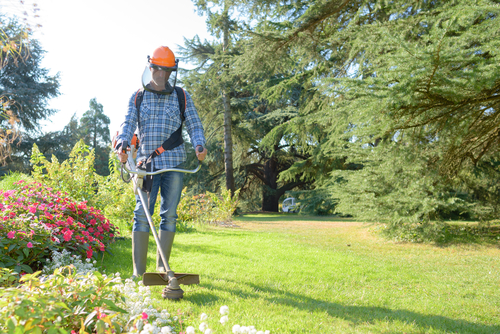
Fertilizing landscapes despite popular belief, is more than just throwing products into the soil and expecting something to happen instantly. Fertilizing takes time and should be done carefully and precisely if you are to get the best possible results. So when conducting landscape maintenance, so that you know what you’re doing, here’s a simple guide people can follow when fertilizing their landscape.
- Choosing A Fertilizer – Fertilizers can be purchased in a liquid, a granule, or a spike form and are mainly used to provide nutrients to soil and plants. Fertilizers when manufactured provide product information that includes an analysis such as 10-6-4, 5-10-5, or 30-7-7.
Here the first number represents the percentage of the nitrogen content in the fertilizer, the second number refers to the phosphorus content, and the third the potassium content in the fertilizer. This information is provided as an indicator to notify people of what exactly they’re purchasing and where it can best be used.
If you come across a fertilizer with these three major plant nutrients based on the NPK analysis, it is called a complete fertilizer and can be used to provide landscapes with a complete set of nutrients in one application.
- Fertilizing Trees – Depending on the landscape goals and what the current nutrient status of the soil is, landscapers can best determine how much and how often to fertilize trees, however, with small trees, these should only be fertilized once a year.
- Fertilizing Plants – Plants absorb fertilizer at any time during the growing season so long as it’s not too dry or the soil is frozen. Fertilizer is usually absorbed by plant roots during the dormant period, once soil temperatures stay above 40 degrees F.
Mulching
As part of landscape maintenance, mulching is also another important element that ought to be considered. Mulching is a great way to further promote health, vigor and beauty throughout your landscape and enables landscapers to benefit in numerous ways. This practice is known to support plant stability and provide nutrients to the soil while preventing weeds and maintaining consistent moisture levels throughout landscapes.
Think of how much time could be saved to do other things just by mulching, since you hardly have to weed or water landscapes. Apart from this mulching can also bring an extra sense of appeal while improving the aesthetics of landscapes, adding color and uniformity to the area.
Just like fertilizing, mulching should be done a particular way, wherein most landscapes mulch can be applied so it covers up to 3 inches above the soil and about 1 inch away from plant stems; As for trees, these can be mulched up to 8 inches off the ground.
People can also visit their local garden center to purchase mulch which can come in the form of wood chippings, bark nuggets, compost and much more. Grass clippings from your regular turf mowing can also be kept and used as mulch.
Don’t Have the Time to Conduct Landscape Maintenance? – Our Team Can Make it Happen for You!
Altogether, landscaping and landscaping maintenance can test the best of gardeners and is not for the faint of heart. Time money and lots of energy have to be put into creating and maintaining a gorgeous landscape.
If you’re retired, you work from home or landscaping is your profession then you may have more time on your hands to keep things with your landscape in order and even then there can still be numerous challenges as you may need help with several tasks. However, if you just don’t have the time or may meet certain challenges in different aspects of landscape maintenance, then we are here to help.
With top-rated landscape maintenance services, here at DK Landscaping we would be happy to come and give you a hand or conduct your landscape maintenance for you.With a knowledgeable, friendly staff, affordable rates and convenient services we can work to keep your landscape looking beautiful any time of year.
Operating efficiently and in any landscape environment, give us a call at to book your appointment or visit us online at dklandscaping.com for more information. Get your landscape maintenance done today, it’s just a call or click away.
Spring Fever? Check Out These Flower Bed Ideas!
Unlike that bad cold you had back in grade school, spring fever is something that you might actually want to catch. You know that you have spring fever if you’ve been planning out flower bed ideas and anxiously eyeing your garden for signs that you can start planting.
From annuals and pair bulbs to spring containers and early bloomers like petite flowers, there are steps that you can start taking today to make that spring fever work for you. The best place to start might be spring-blooming bulbs like daffodils and hardier annuals.
Think Daffodils, Snapdragon, Stock Flowers, Sweet Pea and Hyacinth
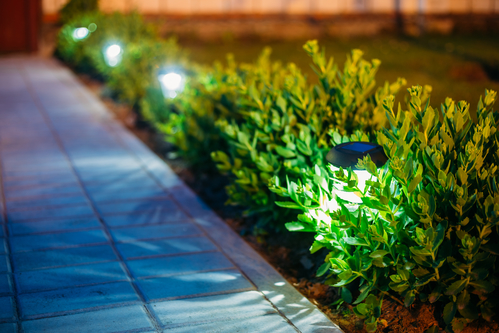
Hardy and half-hardy annuals are the way to go right now if you’ve got a green thumb and you can’t manage to set still. Half-hardy annuals like calendula and snapdragon flowers can withstand a light frost or two and add a full palette of color to your early spring garden.
- Calendula and Dianthus Flowers
Calendula flowers are sometimes known as pot marigold flowers and they’re great because they self-seed so that a handful of seeds really does go a long way towards beautifying your garden. And if you’re looking to add some nice clove scents to your garden, you might also want to throw in a few violet-colored dianthus flowers (growable in containers).
- Snapdragons are Very Hardy
If you’re in a climate that gets truly cold even into late winter, what kinds of flower bed ideas would actually be useful? Well, snapdragons are considered one of the toughest winter hardy flowers in the business since they can come back to full blossom even with significantly subzero temperatures.
- Keep Stock Flowers Around
Stock flowers are also fairly hardy, although they do best in spring and tend to wilt somewhat when summer rolls around. Because they have such a wonderful scent, though, you might consider tucking a container full of stock flowers in the back of your summer garden once they’ve started to wilt come late June.
- Daffodils and Hyacinths
Large bulbs with daffodils and hyacinths are always good to plant alongside your winter hardy flowers in early spring for the extra color and variety that they lend to a spring garden. Whereas peonies and lilacs like to bloom later on in the spring season, daffodils and hyacinths can start a little sooner and give you a head start on your summer garden.
Intersperse Flowering Shrubs with Your Flowers
You really want to think about your spring garden as more of a spring garden landscape. You’re going to be bringing together a lot of different colors, textures, and scents to create a full-on experience. Flowering shrubs look great, smell wonderful, and can even offer the partial shade that daffodils and hyacinths sometimes blossom best under.
- Forsythia Bushes
If you’re in a true four-seasons climate that’s more adventurous than tranquil year round, you might want to consider adding a few forsythia bushes to your spring garden landscape. Forsythia bushes are considered early bloomers, so you can expect to see forsythia’s yellow flowers beautifying your backyard oasis in plenty of time for spring.
- Azalea Blossoms
For more temperate climates where the temperature doesn’t get too cold in late winter or early spring, you should definitely check out azalea blossoms. Azalea is a veritable fixture in the Southeast part of the United States because the ubiquitous good weather there provides the partial shade and leaf litter that azaleas need to thrive and reach their potential.
For more flower bed ideas and advice about how to improve the look of your yard, contact us at DK Landscaping. We provide all our clients with maintenance, repair, irrigation and water savings tips.
Top Gardening Trends For 2018 – Create Your Santa Rosa Xeriscape
Santa Rosa Xeriscape – The Way to go!
Water conservation has become a big deal these days in Santa Rosa and in several other cities in California, since the state has been experiencing severe drought conditions in recent years. Here, authorities have been forced to implement specific regulations and water restrictions in order to facilitate the conservation of water throughout the state.
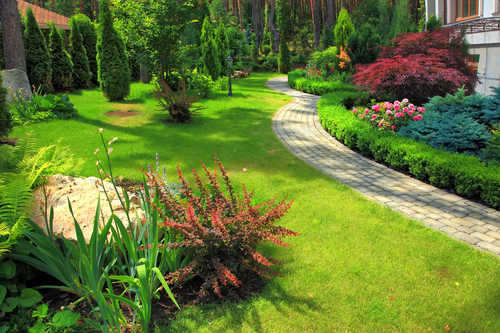
As a result of this many gardeners and landscapers in those areas have had to improvise with their gardening techniques and have been utilizing xeriscaping to keep their gardens in tip-top shape in harsh and limited conditions.
Xeriscaping can bring a whole new meaning to your gardening this year even if the area where you reside is not as dry as others. This technique can help you to save, spend less time watering plants and play your role in conserving water in your district.
FYI – Xeriscapes Make Things Easy For Gardeners Battling Drought
If you live in Santa Rosa or any other city in California that’s drought stricken, then you know that maintaining a healthy and well-nourished garden can be quite the task. Not only because of the harsh and conditions that can exist in some areas but also because of the many issues concerning water conservation.
This is certainly a discouragement for many gardeners as they may fear the worst for their gardens with water regulations being so strict, however there is hope. With your Santa Rosa xeriscape, all your gardening dreams can be made possible and you can still remain compliant with California’s Water Regulations. How?
Well, this particular type of landscaping is specially designed to reduce or eliminate the need for supplemental water to plants, making it easy for gardeners to maintain gardens or landscapes in the scarcity of water. Your Santa Rosa xeriscape does not have to be limited to a single look but can achieve almost any landscaping style conceivable. So whether you have a small garden or are responsible for maintaining a large landscape, using this concept won’t pose any issues with your gardening experience.
Furthermore for your Santa Rosa xeriscape, gardeners can choose from a host of attractive plants that not only show exceptional resilience to harsh conditions but also add variety and appeal to gardens.
Learn How You Can Achieve The Perfect Santa Rosa Xeriscape Following These Easy Steps
The fundamental element of xeriscape design is water conservation, making it the perfect solution for landscape designers who’re constantly searching for ways to reduce the amount water applied to their gardens and to maximize the use of natural precipitation.
Switching to xeriscaping from the more traditional way of landscaping is really quite easy and can be done by any gardener, however, whether you want to redesign an old landscape or create a fresh new, one using xeriscaping, there are a few basic principles that must be followed. These include:
- Planning
To kick off your Santa Rosa xeriscape project, planning is the first thing you should do, where you begin by constructing an aerial view of the site using graph paper, and then marking down North, South, East, and West.
Next, any limiting features such as trees, fences, walkways or structures should be included in plans, noting areas of full sun and full shade to help you to establish areas with different water requirements. You’ll also want to group plants with similar watering needs for most efficient water use.
It is also suggested that gardeners plot areas for seating, walkways, visual barriers, dining or play into plans; carefully constructing a section where larger plantings, such as shrubs and trees can be positioned to provide natural heating and cooling opportunities for adjacent buildings.
Lastly, study the natural contours and drainage patterns of the site to better understand the best or worst location for plants. These contours can be easily developed into terraces, which help to add visual interest and reduce soil loss and erosion.
- Soil Improvement
The next step to creating the perfect Santa Rosa xeriscape would be to improve soil quality on the site. In water-scarce landscapes having the ideal soil conditions does two things: it drains quickly and retains water at the same time. This is achieved by increasing the amount of organic material in your soil and keeping it well aerated.
All you have to do is to purchase some compost from your garden center to help increase the organic matter in your soil, though if you intend to use succulents and cacti in your Santa Rosa xeriscape you may want to work at achieving a leaner soil.
Adding bone meal and rock phosphate to the soil is also another way to boost soil volume and help to improve soil quality, however this is usually done with soils testing a high pH (too alkaline) and low in phosphorus.
- Create Limited Turf Areas
Next, you will need to reduce the size of turf areas as much as possible while retaining an area for open space, functionality and visual appeal. If you intend to plant new turf or reseed an existing lawn, it may be sensible to purchase water-saving species plants adapted to your area from your garden center. This brings us to our next step.
- Use Appropriate Plants
For gardeners to achieve the best results with their Santa Rosa xeriscape, they should select drought-resistant plants native to their region. The plants selected should have leaves which are small, thick, glossy, silver-grey or fuzzy – all characteristics which help them save water. It is also important to choose plants for their ultimate size which will reduce the need for pruning maintenance, especially in hot and dry areas.
Keep in mind to place plants along North and East-facing slopes and walls, that like more moisture but most importantly, it’s best not to mix plants with high and low-watering needs in the same planting area.
- Mulch
Most seasoned gardeners already know that mulching is a great way to promote healthy blooms and landscapes as it helps to retain moisture in the soil, prevent erosion and block troublesome weeds.
With xeriscaping, mulching is also another important aspect of the process and serves basically the same purpose that it would in any other garden. Mulch, such as leaves, wood chips, pine needles or bark should be used and placed to dress the top of soil on occasion, however, for the best results make sure that mulch is at least 3 inches thick and no areas of bare soil are left out.
- Installing Low Drip Irrigation
One of the main purposes of creating a xeriscape is to conserve water and to better facilitate gardens situated in inhospitable areas. Finding efficient ways in which plants can receive the water they need without overwatering can be a bit tricky but by installing a low drip or low volume irrigation system you can certainly pull it off.
This method offers the easiest and most efficient way to supply water just because it delivers water directly to the base of the plant. It also reduces moisture loss, pooling, erosion and is generally the best option when watering plants less frequently.
- Keep Landscapes Well Maintained
Low-maintenance is one of the many benefits of xeriscape, in fact it’s how it got its name; Where the word ‘zero-scaping’, was later substituted with ‘xeriscape’, referring to a landscape that requires zero maintenance.
Although preventing weed growth may require some attention there’s not much for gardeners to maintain when they decide to utilize this form of landscaping. Nevertheless redressing mulch on occasion and cutting turf areas moderately to allow shade for the roots can all be done from time to time to keep your Santa Rosa Xeriscape fresh and healthy.
Get Help Constructing Your Santa Rosa Xeriscape From Scratch – Look Us Up At DK Landscaping Inc. – We’re The Best At Xeriscapes
Following tips can be one thing but when undertaking large gardening projects such as these most people will require an extra hand. Don’t get injured working without the necessary tools or spend long periods of time trying to get projects completed, call the professionals at DK Landscaping.
Producing some of the best Santa Rosa xeriscapes, we strive to incorporate creativity, professionalism and hard work into one service at a fair and affordable price.
We can help you to plan and develop the perfect xeriscape, whether it be residential or commercial. With our xeriscaping services, we offer clients assistance by helping them to choose the right plants, slope sites, mulch areas and install irrigation, this way they can avoid the hassle and save money.
Contact us today at (707) 280-3632 to get started creating your Santa Rosa xeriscape or visit our website at dklandscaping.com for more information on our services.
How Mulch Can Be Applied To Your Garden v2
To keep gardens healthy and vibrant gardeners utilize mulching and it is one of the easiest and more commonly used methods in most gardens. Mulch is mostly available in two forms organic and inorganic and is mainly used to eliminate weed growth, lend additional support to plants and to help plants retain moisture. Mulch can be purchased from any gardening supply store or can even be formulated by gardeners themselves by recycling other products or materials.
Try Mulching!
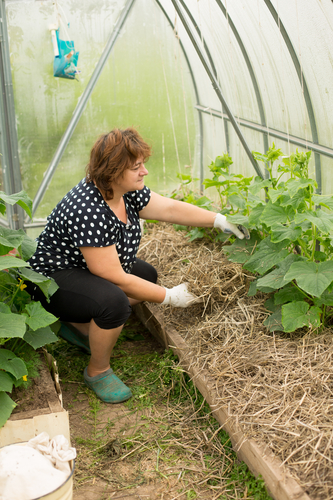
If you mow your lawn the clippings of grass that remain can be converted to mulch. Grass clippings have a high nitrogen content and can be used to naturally fertilize plants but works exceptionally well to fertilize vegetables.
For gardeners who have enough compost this too can be used as mulch. Once it isn’t dried out compost is great for enriching soil but to ensure that it provides the necessary nutrients and remains biologically active another layer of mulch such as chopped leaves should be added to cover the compost.
There are so many different things found in and around gardens that can be used to mulch. Having said using straw or hay throughout gardens is another excellent mulching option. It has most of the benefits of other mulches while adding organic matter to soil as it decomposes.
Gardeners should keep in mind when using hay or straw to make sure it is weed and seed free when making applications. They should also ensure that it is not placed too close to stems to prevent attracting slugs and rodents.
Did you know that mulching a vegetable garden with sheets of black plastic film can do wonders? This is another neat, gardening and mulching alternative that has proven to be very effective where the black plastic transmits the sun’s heat to the soil beneath, creating a microclimate that is about three degrees warmer than a garden that does not have mulch applied.
Since the plastic film remains warm and dry fruits and vegetables are protected, they don’t rot and they are kept clean. As with other mulches it prevents weed growth and retains moisture however when using plastic gardeners should remember to punch holes so that soil can still receive air and that plants and seeds can be transplanted or sown.
As we may know some mulches come in inorganic forms as well. Gravel, stones, and geotextiles can all be used to mulch gardens. Even though some are of a hard or rough texture and do not filter nutrients into soil they still allow air and water through to the soil beneath while keeping weeds from coming up.
These are all great ways to recycle materials or products in and around gardens or homes as well as to help gardeners to save money. Mulching is great for plants and vegetables and promotes a healthy environment throughout gardens so if you haven’t already maybe it’s time you start as you don’t even have to buy it you can make it and apply it yourself. Contact us for more information.
Have A Narrow Walkway? Try These Gardening Tips
There are quite a few gardeners out there who have an extensive knowledge of plants and landscaping in which they use to come up with some very impressive and unique ideas for their gardens. However there are still many amateur gardeners or homeowners out there who love to beautify their properties and are excited about doing new things but lack gardening knowledge.
Try These Gardening Ideas
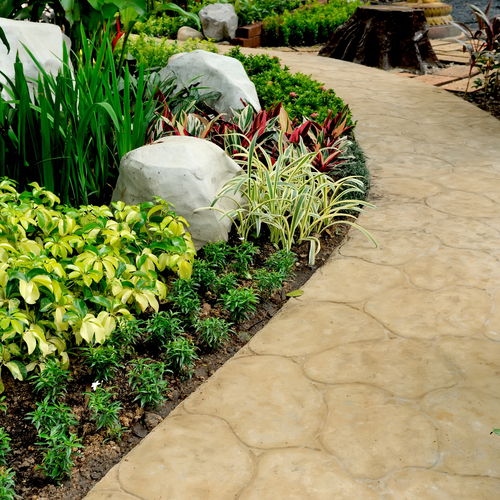
This might be just what you are looking for as this article offers some pretty insightful and dynamic tips that people can utilize to create gorgeous landscape designs while adding ambience and character to their surroundings.
Before focusing on choice of plants a great idea might be to add an outstanding feature to accessorize the garden and surrounding areas of the home. Installing an ornamental gate at the entrance of your walkway is a great start. This will immediately make the walkway feel more private for you and still feel inviting to visitors.
Once this is done establishing a focal point in the garden or surroundings would be the next step. Using an attractive tree, bird bath or bench brimmed with brightly colored plants can serve to draw the eye beyond the walkway while enhancing the appearance of the entire garden.
If the walkway or pavement needs repair it would be best to ensure that this is done in the initial stages. You should not wait until after you’ve planted the flanking beds mainly because this is exactly where you or your contractor will need to tread while working on the path or pavement. So to avoid the destruction of garden beds make sure you do any necessary repairs before proceeding to that stage.
Once you have secured and established the basic groundwork for your garden you want to make sure you choose the correct plants trees and flowers. If you reside in an urban area the best plants to use are low-growing perennials. Besides their beautiful shades most of them die in the winter or can be cut to the ground. This makes it easier for gardeners when dealing with the snow as well and when it’s time to regrow the next growing season.
- The Ajuga, lysimachia, and creeping phlox species all spread like a carpet and Ajuga reptans ‘Catlin’s Giant’ has burgundy-bronze leaves that supply color to surroundings long after its deep-blue flower spikes fade in late spring.
- The Lysimachia nummularia species possesses a delicate, looking foliage that covers ground quickly and softens the edges of a path.
To add more color and variety consider using the Phlox stolonifera species which is popular for the graceful flower clusters it sends up on 8-inch stems in late spring. The wild form is usually bluish but there are also blue, white, and pink varieties.
To give an added touch to your paths or walkways using slightly taller plants would be best. They won’t bend into the way of people using the walkway and at the same time they add a contrasting feature to the surroundings. Be sure though to avoid using plants more than 8 inches tall to prevent overgrowth in the walkway along with overshadowing other features within the garden.
Ensuring that a safe and nurturing environment is maintained throughout, gardens and surroundings should be the priority of every gardener. If in difficulty or you may be lost in some areas hiring a professional would be the best course of action, but if you are just looking for tips to improve and enhance there are a network of informative and effective tips available online that give tremendous insight into how those ideas can be achieved. Contact us for more information.


